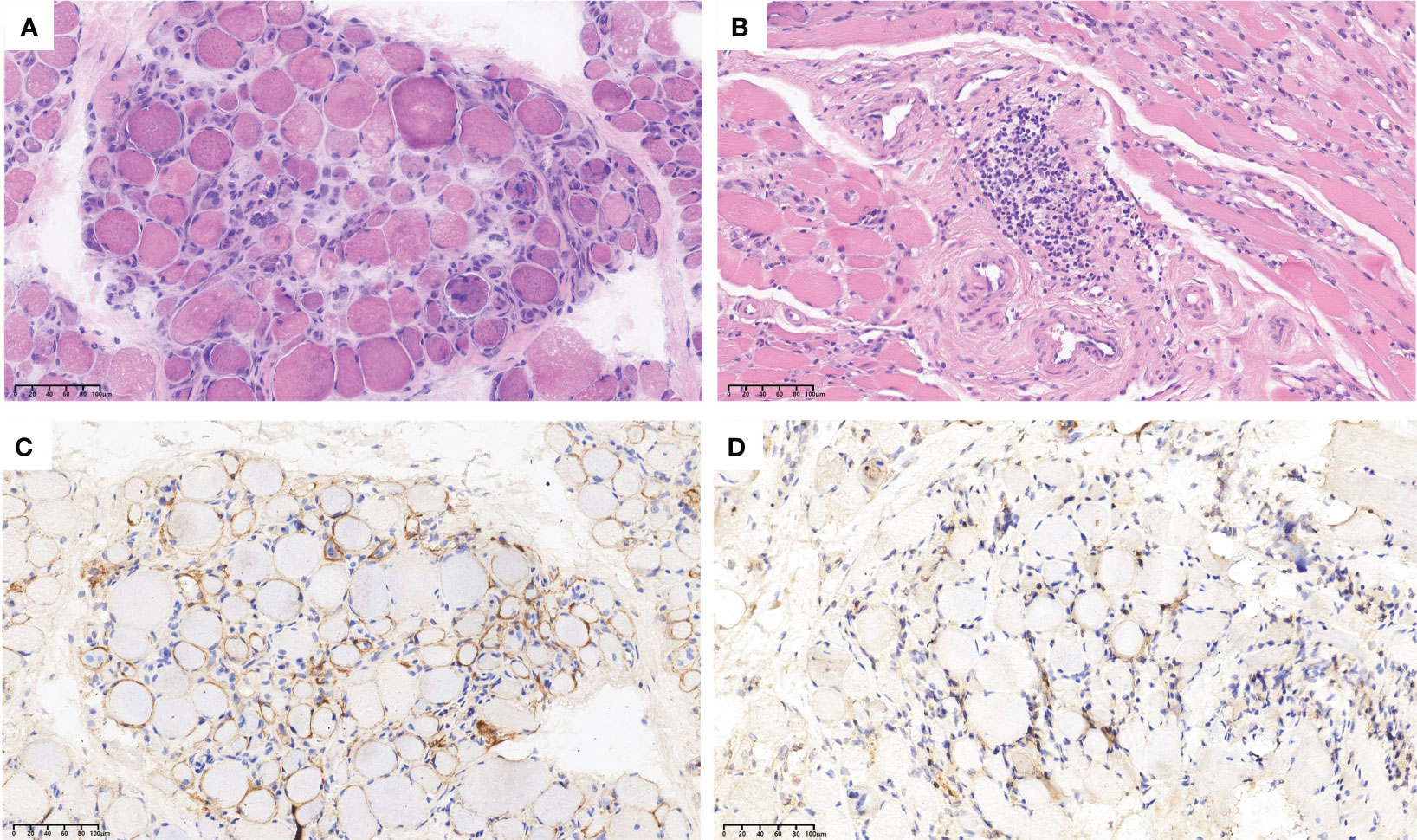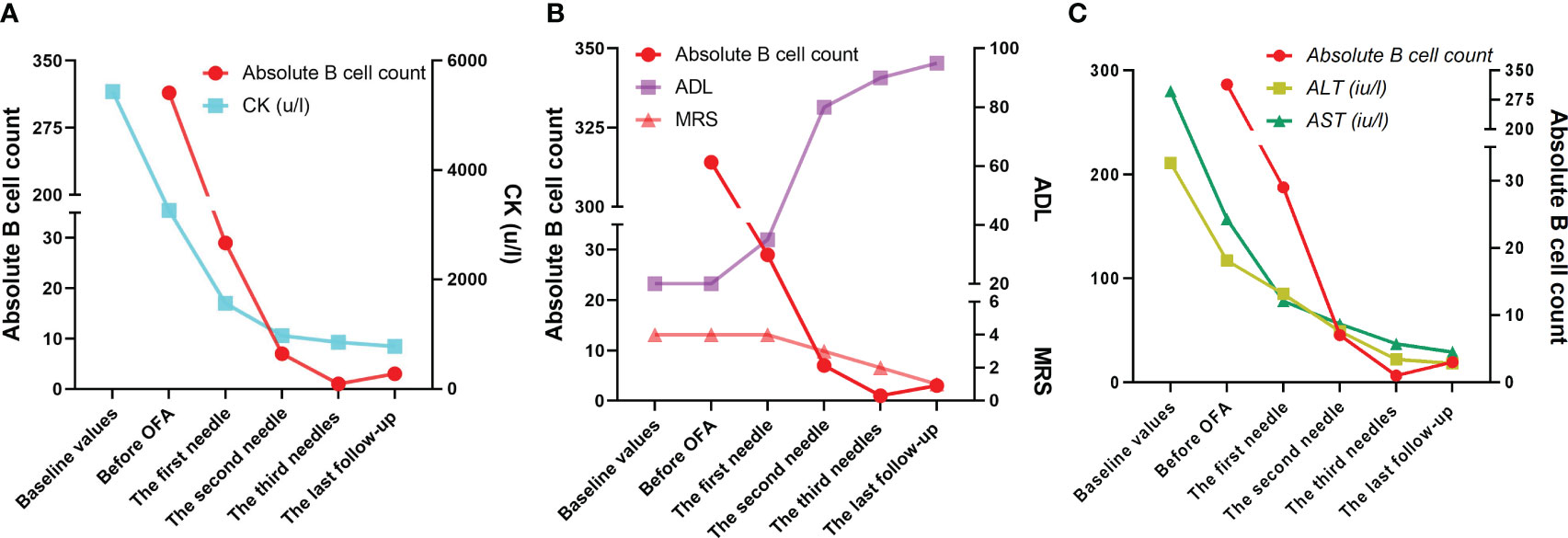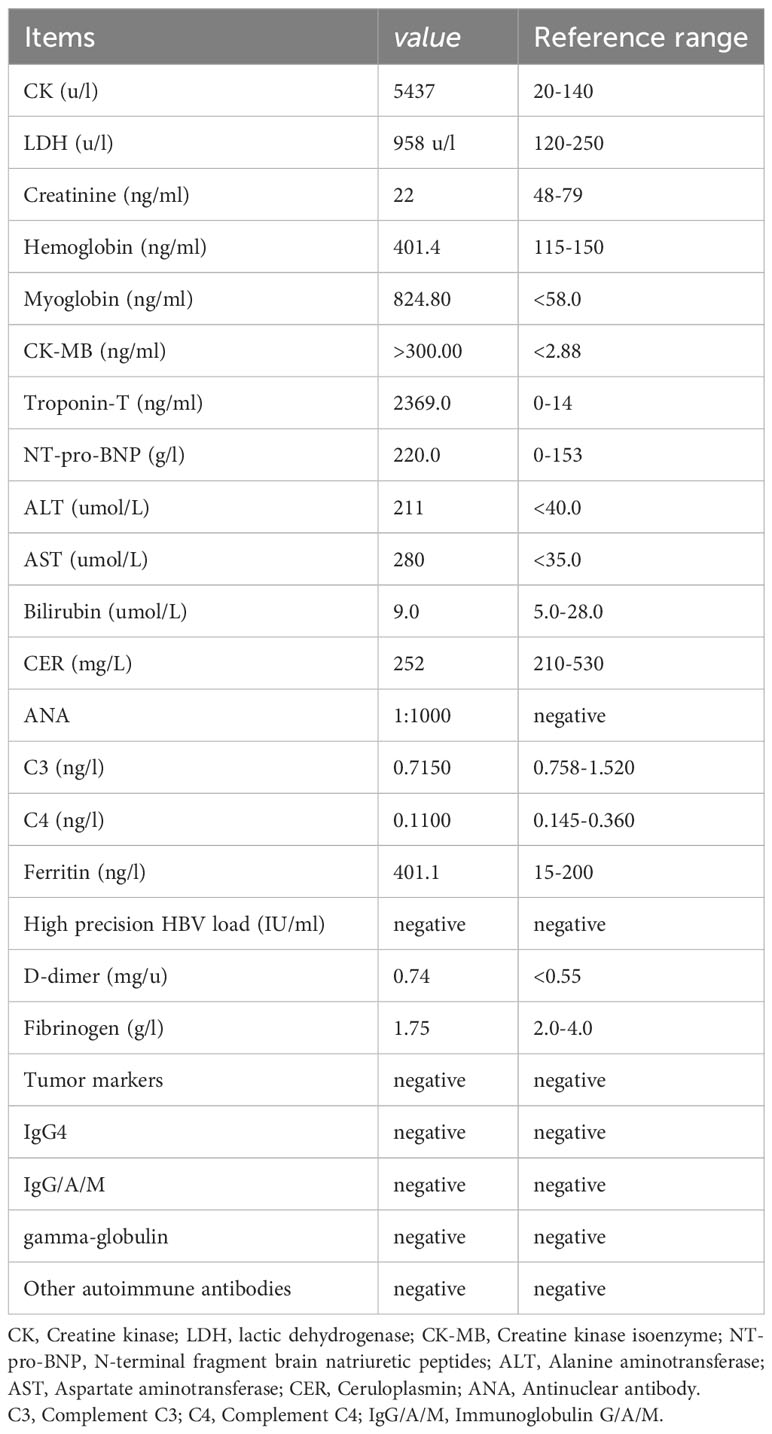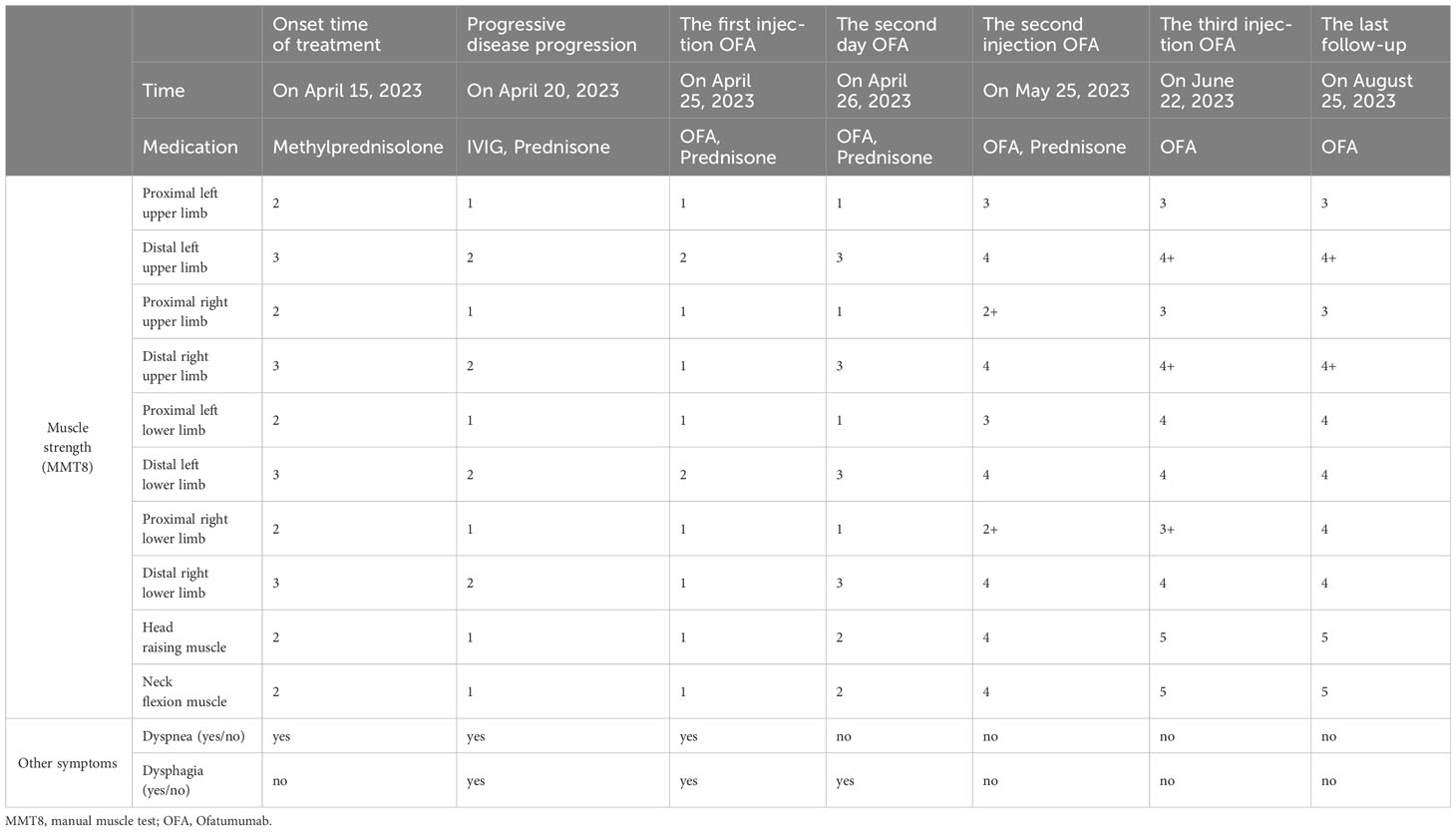- 1Department of Neurology, West China Hospital, Sichuan University, Chengdu, Sichuan, China
- 2Department of Pathology, West China Hospital, Sichuan University, Chengdu, Sichuan, China
Background: Immune-mediated necrotizing myopathies (IMNM) is a rare disease that was first described in 2004. Due to the lack of large case series, there are no formal treatment recommendations for IMNM.
Methods: We presented a case of a 47-year-old woman who experienced progressive limb weakness, starting from the lower limbs and gradually affecting the upper limbs. She also reported experiencing dyspnea after engaging in daily activities. When she was admitted to the hospital, her upper limbs were almost unable to move and she could not stand even with support. Her Creatine kinase (CK) level significantly increased (> 3500 u/l). Electromyography showed myogenic damage, anti-Signal recognition particle (anti-SRP) and anti-Ro52 antibodies were highly positive. Pathological biopsy of the right biceps muscle showed necrotizing myopathy in the skeletal muscle. She was ultimately diagnosed with anti-SRP IMNN, and was given monotherapy with methylprednisolone and combination therapy with immunoglobulin, but her symptoms continued to worsen. The patient refused to bear the possible further liver dysfunction and blood system damage caused by Cyclophosphamide and Rituximab, and she chose to try to use Ofatumumab (OFA).
Results: After receiving three doses of OFA treatment without any adverse reactions, she reported that her muscle strength had basically recovered and she was able to walk independently. The B cells in the circulatory system have been depleted, and blood markers such as liver function have consistently remained within normal range. During the follow up, her activity tolerance continued to improve.
Discussion: We have presented a severe case of SRP-IMNM in which the patient showed poor response to conventional immunotherapy. However, rapid symptom relief was achieved with early sequential use of OFA treatment. This provides a new option for the treatment of SRP-IMNM, and more large-scale studies will be needed in the future to verify our results.
Case report
A 47-year-old woman presented to the gastroenterology outpatient clinic with elevated levels of alanine aminotransferase (ALT) and aspartate aminotransferase (AST), measuring 211IU/L and 280IU/L respectively. She only presented a slight fatigue, and the laboratory examination showed a high positive Hepatitis A Virus-IgG (HAV-IgG) antibodies and antinuclear antibody (ANA) greater than 1:1000. She has no underlying medical conditions and she had received regular annual physical examination on March 2023. The result of chest CT showed no abnormalities at that time. Therefore, she was diagnosed with AIH despite the lack of liver biopsy evidence. She received the treatment of entecavir 10mg q.d and prednisone 4mg q.d for two months, but her liver function and physical endurance did not show evident improvement. After infected with coronavirus-19 (COVID-19), and her condition rapidly deteriorated, as she began experiencing difficulties in lifting her neck, walking, holding objects with both hands, and even developed dyspnea during moderate activities. When she was admitted, the muscle power of Grade 2 (MMT8 score) proximal, Grade 3 distal muscle strength of the limbs, and Grade 2 the head raising and neck flexion muscle strength without significant muscle atrophy or fasciculation. Tendon reflexes were absent, Babinski’s sign, sensory and autonomic abnormalities were negative.
The laboratory examination revealed a significant increase in levels of creatinine kinase (CK) and myocardial markers (Table 1). Electromyography (EMG) showed typical features of myopathic impairments (Supplementary Material). Myositis-specific autoantibodies including anti-SRP and anti-Ro52 antibody were high positive (+++). Biopsy of the right biceps brachii muscle showed necrotizing myopathy with minimal local inflammation (Figure 1). Echocardiography (ECHO) showed a small amount of pericardial effusion, and electrocardiogram showed abnormal ST-T segment changes. Further examinations did not reveal the presence of an underlying tumor, and the patient denied having any other diseases. She was diagnosed with SRP- IMNM according to the new European Neuromuscular Centre criteria (1).

Figure 1 Histopathological and immunohistochemical analysis (H&E) revealed a significant presence of degenerated, necrotic, and regenerating muscle fibers with heterogeneous sizes (A); Around the perimysium of small blood vessels, there were clusters and infiltration of lymphocytes (B); C5b-9 showed strong positivity on the muscle fiber membrane (C); MHC-I was also expressed on the muscle fiber membrane (D).
The patient was initially treated with methylprednisolone for 5 days (1 g/day), but her muscle weakness became progressively worsened (Grade 1 the head raising and neck flexion muscle strength, Grade 1 proximal and Grade 2 distal muscle strength of the limbs), with dysphagia and more severe dyspnea. She underwent high-resolution chest CT immediately, which revealed mild interstitial changes in her lungs. Then, she received intravenous IVIG (0.4mg/kg/d) for 5 days, but her condition was not attenuated. Sequential immunotherapy with a second round of IVIG, rituximab (RTX), cyclophosphamide and OFA was recommended. However, the patient and her guardians chose OFA but refused other recommendations because they worried about the potential side effects especially the impairment of liver function.
On the second day after the completion of IVIG, she received the first dose of OFA (20 mg) via subcutaneous injection. On the second day of first OFA therapy, her muscle strength of limbs and dyspnea were markedly improved (the head raising and neck flexion muscle strength recovered to Grade 2, and distal muscle strength of the limbs recovered to Grade 3), and the absolute B cell counts decreased from 314 to 29 (cell/ul). The patient received the second and third needle of OFA once a month, and the dose for these two injections was 20mg each. Her activity tolerance continued to improve, and B cell remained at a relatively low level during the use of OFA (Figure 2). The changes of her clinical symptoms during the treatment are shown in Table 2. Myocardial markers, ECG and ECHO returned to normal, but the EMG at two follow-up visits showed that nerve conduction velocities in the extremities were normal but without any improvement in the typical myopathy features (Supplementary Material).

Figure 2 During treatment with OFA, the patient’s CK level declined in line with his absolute B-cell count (A). The MRS scores increased with the decrease of absolute B cell count, but the ADL scores increased significantly, indicating that her ability of daily living was significantly improved (B). ALT and AST levels decreased as the patient’s absolute B-cell count decreased, and both normalized by the second dose of OFA (C). OFA, Ofatumumab; CK, Creatine Kinase; MRS, Modified Rankin Scale; ADL, Activity of Daily Living Scale; ALT, Alanine aminotransferase; AST, Aspartate aminotransferase.
Discussion
The present case was initially diagnosed as AIH. Although both ALT and AST levels can be derived from liver and muscle, ALT is mainly derived from the liver, while AST is primarily derived from the heart and muscle (2). In this patient, the significantly higher AST compared to ALT, without any cardiac involvement, raised concerns about muscle damage. In addition, a recent study found that some IMNM patients may remain asymptomatic for a long time, with only abnormalities in liver enzymes (3). Therefore, abnormal liver function may be a subclinical manifestation in IMNM; CK and EMG examinations are helpful for the diagnosis.
Our patient experienced a significant worsening of clinical symptoms following the COVID-19 infection. Several case reports have been published regarding IMNM associated with COVID-19 infections (4–6). These reports highlighted the potential connection between infections and the exacerbation of IMNM symptoms. COVID-19 may cause IMNM either by infecting muscle fibers directly or by activating the complement system by virus-antibody complexes and viral toxin deposition (7). Interestingly, the patient’s symptoms showed significant improvement after OFA treatment, although there were no significant changes observed in the EMG results. It is possible that the already necrotic muscle cells were too severe to be salvaged or that the follow-up time was not sufficient to observe changes in the EMG. However, the decrease in spontaneous potential does suggest a controlled progression of the acute phase.
Anti-B cell therapy is currently being explored as a potential treatment for IMNM (8). However, when second-line therapies including anti-B cell therapy should be initiated, is still in the exploratory stage. In a study involving 18 IMNM patients treated with RTX, it was observed that more than half of these patients experienced either no or only partial clinical remission. The authors suggested that this outcome may be attributed to the delayed administration of RTX (1). A recent case reported the efficacy of OFA in treating refractory SRP-IMNM (9). Unlike RTX, OFA is a human IgG1 monoclonal antibody against which prevents the risk of antidrug-antibodies production. A previous study has found that the patient who had severe adverse reactions to the infusion of RTX can still be safely and effectively treated with OFA (10). OFA also has the ability to increase B cell binding affinity and enhance complement-dependent cytotoxicity (11). Other studies have also demonstrated the significant therapeutic effects of OFA for conditions resistant to RTX, such as nephrotic syndrome and other systemic autoimmune diseases (12, 13).
We presented a case of severe IMNM in which early administration of OFA was initiated. This patient experienced difficulties with swallowing and breathing as the disease progressed. Despite receiving high-dose methylprednisolone and IVIG treatment, there was no improvement. However, these symptoms rapidly improved following OFA treatment. The rapid clinical improvement observed following OFA treatment and the close correlation between circulating B cell counts and clinical presentation suggest a significant role for OFA in the treatment of SRP-IMNN. In addition, this patient did not report any adverse effects and she has a continued improvement in liver function during the administration of OFA, suggesting the safety and well tolerated of OFA.
Our case is different from the previous case (9). Our patient was treated with OFA the day after the end of IVIG treatment, whereas that case started OFA 10 days after the end of conventional immunotherapy. Our patient seems to have faster clinical remission than that patient. Previous studies have also shown that delayed use of RTX may not be conducive to the improvement of clinical symptoms in patients with IMNM (1). Actually, our study explores the potential of “triple therapy,” incorporating OFA, and proposes that earlier initiation of OFA treatment may offer greater benefits to patients with severe SRP-IMNM. From the mechanism of drug action, IVIG has unique advantages for pre-existing autoimmune antibodies in the circulatory system. IVIG has a broad-spectrum effect against normal human proteins and some special antibodies, allowing it to rapidly neutralize autoimmune antibodies. However, there was no significant effect on pathogenic B cells (12). OFA plays a role mainly through the combination of two unique epitopes on CD20-expressing B cells, inducing the lysis and elimination of pathogenic B cells and reducing the re-production of autoimmune antibodies (13). Therefore, IVIG and OFA may have a synergistic effect in the treatment of IMNM, and earlier sequential use of OFA may provide greater benefit to the severe SRP-IMNM patients.
Although significant efficacy has been observed, we still need further follow-up to clarify the role of OFA in long-term prognosis and recurrence of SRP-IMNN patients.
Conclusion
Early or asymptomatic anti-SRP-IMNN should be differentiated from liver disease. For severe anti-SRP-INMN patients with a poor response to conventional immunotherapy, early sequential OFA therapy may be an effective, safe, and convenient choice.
Data availability statement
The original contributions presented in the study are included in the article/Supplementary Material. Further inquiries can be directed to the corresponding author.
Ethics statement
The studies involving humans were approved by Ethics Committee of West China Hospital, Sichuan University. The studies were conducted in accordance with the local legislation and institutional requirements. The participants provided their written informed consent to participate in this study. Written informed consent was obtained from the individual(s) for the publication of any potentially identifiable images or data included in this article.
Author contributions
SC: Data curation, Investigation, Writing – original draft, Writing – review & editing. JY: Investigation, Resources, Supervision, Writing – review & editing. DH: Data curation, Resources, Supervision, Writing – original draft. JF: Data curation, Writing – review & editing. XL: Data curation, Writing – review & editing. BZ: Data curation, Resources, Writing – review & editing. XC: Resources, Supervision, Writing – review & editing. HS: Data curation, Resources, Supervision, Writing – review & editing.
Funding
The author(s) declare financial support was received for the research, authorship, and/or publication of this article. This study was supported by the Clinical Research Incubation Project of West China Hospital of Sichuan University (Grant No.20HXFH035), and the grant from the Cadres Health Care Project in Sichuan Province (Grant No. 2023–111).
Acknowledgments
We are grateful to this patient and her family for their participation in this study.
Conflict of interest
The authors declare that the research was conducted in the absence of any commercial or financial relationships that could be construed as a potential conflict of interest.
Publisher’s note
All claims expressed in this article are solely those of the authors and do not necessarily represent those of their affiliated organizations, or those of the publisher, the editors and the reviewers. Any product that may be evaluated in this article, or claim that may be made by its manufacturer, is not guaranteed or endorsed by the publisher.
Supplementary material
The Supplementary Material for this article can be found online at: https://www.frontiersin.org/articles/10.3389/fimmu.2023.1301109/full#supplementary-material
References
1. Allenbach Y, Mammen AL, Benveniste O, Stenzel W, Amato A, Aussy A, et al. 224th ENMC International Workshop:: Clinico-sero-pathological classification of immune-mediated necrotizing myopathies Zandvoort, The Netherlands, 14-16 October 2016. Neuromuscul Disord (2018) 28(1):87–99. doi: 10.1016/j.nmd.2017.09.016
2. Panteghini M. Aspartate aminotransferase isoenzymes. Clin Biochem. (1990) 23(4):311–9. doi: 10.1016/0009-9120(90)80062-nIF
3. Triplett JD, Pamphlett R, Wang MX, Yiannikas C. Anti-SRP associated necrotizing autoimmune myopathy presenting with asymptomatically elevated creatine kinase. Muscle Nerve (2019) 59(3):E17–e19. doi: 10.1002/mus.26388
4. Dalakas MC. Guillain-Barré syndrome: The first documented COVID-19-triggered autoimmune neurologic disease: More to come with myositis in the offing. Neurol Neuroimmunol Neuroinflamm (2020) 7(5). doi: 10.1212/NXI.0000000000000781
5. Ibrahim A, Ghazali WSW, Misyail A, Najwa L, Khan AH, Amir WM, et al. Immune-mediated necrotizing myopathy (NAM) related to SARS-Cov-2 infection: a case report. BMC Neurol (2023) 23(1):117. doi: 10.1186/s12883-023-03170-1
6. Chan KH, Slim J. Rhabdomyolysis as potential late complication associated with COVID-19. Emerg Infect Dis (2020) 26(10):2535. doi: 10.3201/eid2610.202225
7. Cabello-Verrugio C, Morales MG, Rivera JC, Cabrera D, Simon F, Cabello-Verrugio C, et al. Renin-angiotensin system: an old player with novel functions in skeletal muscle. Med Res Rev (2015) 35(3):437–63. doi: 10.1002/med.21343
8. Cui BB, Tian YR, Ma XY, Yin G, Xie QB. Belimumab for immune-mediated necrotizing myopathy associated with anti-SRP antibodies: A case report and retrospective review of patients treated with anti-B-cell therapy in a single center and literature. Front Immunol (2021) 12:777502. doi: 10.3389/fimmu.2021.777502
9. Wen C, Yang J, Wei DS, Xu CY, Yu P, Luo LJ, et al. Anti-signal recognition particle antibody-positive immune-mediated necrotizing myopathy treated with ofatumumab. Rheumatol (Oxford) (2023). doi: 10.1093/rheumatology/kead424
10. Cao S, Du J, Pan SD, Zhang JJ, Xu S, Wei L, Tian YH, et al. Case Report: Ofatumumab treatment in a patient with rituximab-intolerant refractory autoimmune GFAP astrocytopathy. Front Immunol (2023) 14:1164181. doi: 10.3389/fimmu.2023.1164181
11. Robak T, Robak E. New anti-CD20 monoclonal antibodies for the treatment of B-cell lymphoid Malignancies. BioDrugs (2011) 25(1):13–25. doi: 10.2165/11539590-000000000-00000
12. Ronda N, Haury M, Nobrega A, Coutinho A, Kazatchkine MD. Selectivity of recognition of variable (V) regions of autoantibodies by intravenous immunoglobulin (IVIg). Clin Immunol Immunopathol (1994) 70(2):124–8. doi: 10.1006/clin.1994.1019
Keywords: anti-SRP, immune-mediated necrotizing myopathy, ofatumumab, OFA, case report
Citation: Chen S, Yang J, He D, Fu J, Lai X, Zhao B, Chen X and Shang H (2023) Anti-SRP immune-mediated necrotizing myopathy responsive to ofatumumab: a case report. Front. Immunol. 14:1301109. doi: 10.3389/fimmu.2023.1301109
Received: 24 September 2023; Accepted: 05 December 2023;
Published: 19 December 2023.
Edited by:
Mattia Bellan, University of Eastern Piedmont, ItalyReviewed by:
Naveen R., Sanjay Gandhi Postgraduate Institute of Medical Sciences, IndiaEduard Gallardo, Institut de Recerca de l’Hospital de la Santa Creu i Sant Pau, Spain
Copyright © 2023 Chen, Yang, He, Fu, Lai, Zhao, Chen and Shang. This is an open-access article distributed under the terms of the Creative Commons Attribution License (CC BY). The use, distribution or reproduction in other forums is permitted, provided the original author(s) and the copyright owner(s) are credited and that the original publication in this journal is cited, in accordance with accepted academic practice. No use, distribution or reproduction is permitted which does not comply with these terms.
*Correspondence: Xueping Chen, Y2hlbnh1ZXBpbmcwNjA2QHNpbmEuY29t
†These authors have contributed equally to this work and share first authorship
 Sihui Chen1†
Sihui Chen1† Jing Yang
Jing Yang Jiajia Fu
Jiajia Fu Xiaohui Lai
Xiaohui Lai Bi Zhao
Bi Zhao Xueping Chen
Xueping Chen
